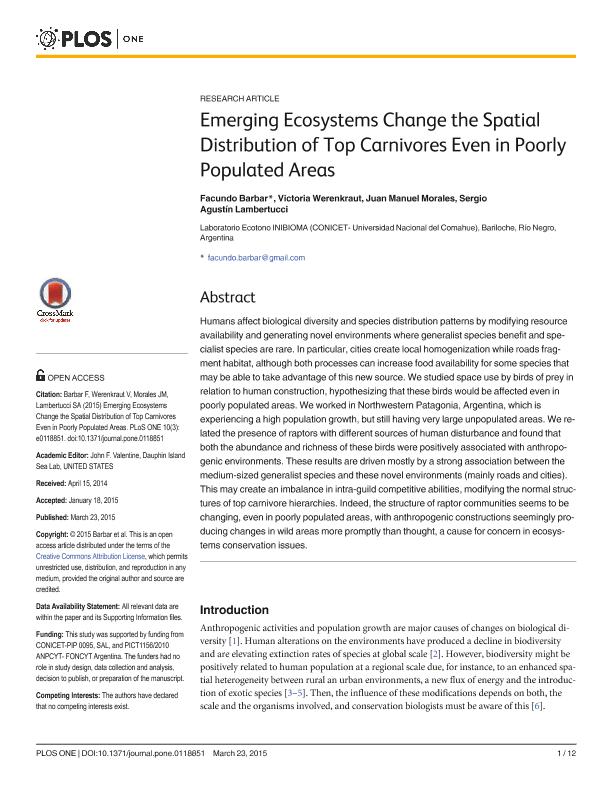Mostrar el registro sencillo del ítem
dc.contributor.author
Barbar, Facundo

dc.contributor.author
Werenkraut, Victoria

dc.contributor.author
Morales, Juan Manuel

dc.contributor.author
Lambertucci, Sergio Agustin

dc.date.available
2017-01-26T20:54:57Z
dc.date.issued
2015-03
dc.identifier.citation
Barbar, Facundo; Werenkraut, Victoria; Morales, Juan Manuel; Lambertucci, Sergio Agustin; Emerging Ecosystems Change the Spatial Distribution of Top Carnivores Even in Poorly Populated Areas; Public Library Of Science; Plos One; 10; 3; 3-2015; 1-12
dc.identifier.issn
1932-6203
dc.identifier.uri
http://hdl.handle.net/11336/12048
dc.description.abstract
Humans affect biological diversity and species distribution patterns by modifying resource availability and generating novel environments where generalist species benefit and specialist species are rare. In particular, cities create local homogenization while roads fragment habitat, although both processes can increase food availability for some species that may be able to take advantage of this new source. We studied space use by birds of prey in relation to human construction, hypothesizing that these birds would be affected even in poorly populated areas. We worked in Northwestern Patagonia, Argentina, which is experiencing a high population growth, but still having very large unpopulated areas. We related the presence of raptors with different sources of human disturbance and found that both the abundance and richness of these birds were positively associated with anthropogenic environments. These results are driven mostly by a strong association between the medium-sized generalist species and these novel environments (mainly roads and cities). This may create an imbalance in intra-guild competitive abilities, modifying the normal structures of top carnivore hierarchies. Indeed, the structure of raptor communities seems to be changing, even in poorly populated areas, with anthropogenic constructions seemingly producing changes in wild areas more promptly than thought, a cause for concern in ecosystems conservation issues.
dc.format
application/pdf
dc.language.iso
eng
dc.publisher
Public Library Of Science

dc.rights
info:eu-repo/semantics/openAccess
dc.rights.uri
https://creativecommons.org/licenses/by/2.5/ar/
dc.subject
Cities
dc.subject
Distribution Patterns
dc.subject
Human Impact
dc.subject
Patagonia
dc.subject
Raptors
dc.subject
Roads
dc.subject.classification
Ecología

dc.subject.classification
Ciencias Biológicas

dc.subject.classification
CIENCIAS NATURALES Y EXACTAS

dc.title
Emerging Ecosystems Change the Spatial Distribution of Top Carnivores Even in Poorly Populated Areas
dc.type
info:eu-repo/semantics/article
dc.type
info:ar-repo/semantics/artículo
dc.type
info:eu-repo/semantics/publishedVersion
dc.date.updated
2016-12-12T14:29:41Z
dc.journal.volume
10
dc.journal.number
3
dc.journal.pagination
1-12
dc.journal.pais
Estados Unidos

dc.journal.ciudad
San Francisco
dc.description.fil
Fil: Barbar, Facundo. Consejo Nacional de Investigaciones Científicas y Técnicas. Centro Científico Tecnológico Patagonia Norte. Instituto de Investigación En Biodiversidad y Medioambiente; Argentina. Universidad Nacional del Comahue. Centro Regional Universitario Bariloche. Laboratorio de Ecotono; Argentina
dc.description.fil
Fil: Werenkraut, Victoria. Consejo Nacional de Investigaciones Científicas y Técnicas. Centro Científico Tecnológico Patagonia Norte. Instituto de Investigación En Biodiversidad y Medioambiente; Argentina. Universidad Nacional del Comahue. Centro Regional Universitario Bariloche. Laboratorio de Ecotono; Argentina
dc.description.fil
Fil: Morales, Juan Manuel. Consejo Nacional de Investigaciones Científicas y Técnicas. Centro Científico Tecnológico Patagonia Norte. Instituto de Investigación En Biodiversidad y Medioambiente; Argentina. Universidad Nacional del Comahue. Centro Regional Universitario Bariloche. Laboratorio de Ecotono; Argentina
dc.description.fil
Fil: Lambertucci, Sergio Agustin. Consejo Nacional de Investigaciones Científicas y Técnicas. Centro Científico Tecnológico Patagonia Norte. Instituto de Investigación En Biodiversidad y Medioambiente; Argentina. Universidad Nacional del Comahue. Centro Regional Universitario Bariloche. Laboratorio de Ecotono; Argentina
dc.journal.title
Plos One

dc.relation.alternativeid
info:eu-repo/semantics/altIdentifier/url/http://journals.plos.org/plosone/article?id=10.1371/journal.pone.0118851
dc.relation.alternativeid
info:eu-repo/semantics/altIdentifier/doi/http://dx.doi.org/10.1371/journal.pone.0118851
Archivos asociados
